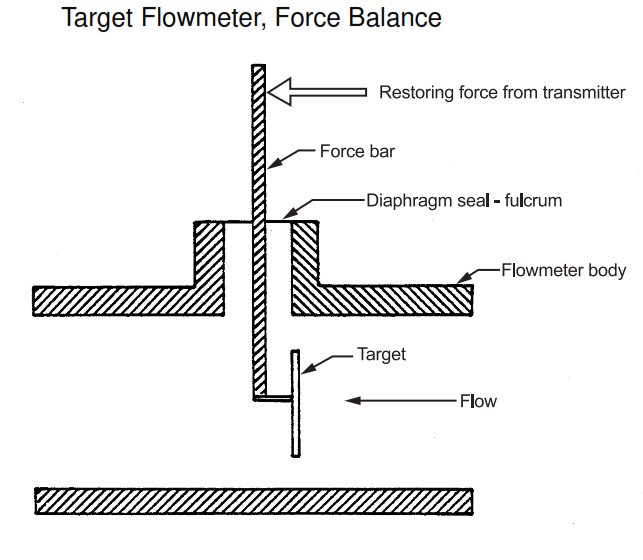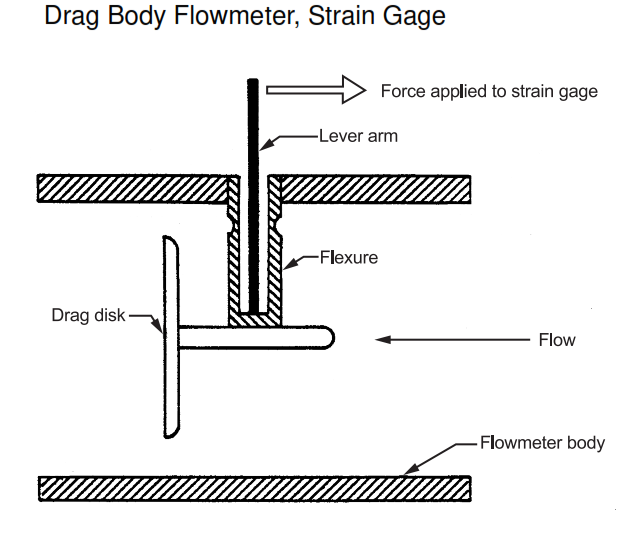This article is for target flowmeters; their suitability, advantages and disadvantages; and precautions in their application. Main keywords for this article are Target Flowmeter Design Requirements in Process Plants. Advantages of Target Flowmeter. Disadvantages of Target Flowmeter. Applications of Target Flowmeter, References Target Flowmeter.
References Target Flowmeter
Reference is made in this standard to the following documents.
American National Standards Institute (ANSI)
B16.5 Cast Iron Pipe Flanges and Flanged Fittings
Target Flowmeter Design Requirements in Process Plants
- The target flowmeter combines an annular orifice and a transmitter in a single unit. The annular orifice is formed by a round target positioned in the center of the tubular flow section (meter body).
- The moving fluid exerts a force on the target. This force is transmitted through a force bar which pivotson a flexible seal diaphragm – fulcrum, or a flexure, to the outside of the flowmeter body. A pneumatic or electronic force balance transmitter, or a strain gage measures the force exerted. The flow rate is proportional to the square root of the force, and thus to the square root of the transmitted signal.
Limiting Conditions of Target Flowmeter
- The body of flowmeter shall be constructed with 316 stainless steel or better.
- The inside diameter of the flowmeter bore and its piping shall match. The flowmeter body shall also be aligned as closely as practical with the pipe.
- The viscosity of flowing liquid shall be greater than 1 cp.
- The flow pattern shall have Reynolds number greater than 4000 to maintain accuracy.
Applications of Target Flowmeter
- The target flowmeter is useful in the measurement of high viscosity liquids and hot, tarry, sediment-bearing liquids where sensing lines would plug. It may also be used for gas and vapor flow
measurement. - Normal maximum working limits for the target flowmeter are determined by the mounting flanges.
- These flowmeters clamp between a pair of pipe flanges and are suitable for operation from full vacuum to the mounting flange rating specified in ANSI B16.5. The maximum process temperature is 260°
C and the ambient temperature limits are minus 40 to 121° C. The electronic version needs a remote amplifier if the ambient temperature is above 82° C. Versions are available with 5000 psig rating. - To avoid errors from upstream and downstream piping influences, the target flowmeter shall be installed in accordance with orifice piping practices.
Advantages of Target Flowmeter
- The target flowmeter is more suitable than other differential flowmeters for the measurement of high viscosity liquids and hot, tarry, sediment-bearing liquids.
- The absence of impulse lines eliminates the need for seals, purge systems, and freeze protection.
- Flow is not impeded at the top or bottom of the pipe, so gas and sludge flows are not restricted.
- The target flowmeter is less sensitive to Reynolds number changes than an orifice.
- It may reduce the possibility of human exposure to toxic materials because of the elimination of external piping and valves.
- The installed system accuracy of target flowmeters is better than other head-type flowmeters. It is immune to the errors associated with sensing lines.
Disadvantages of Target Flowmeter
- The target flowmeter cannot be zeroed except under zero flow conditions. On-site calibration is not possible.
- Empirical data is not as complete as for orifices.
- Accuracy is highly dependent upon proper installation and piping. Special installation alignment tools may be required.
- There is a high permanent pressure loss, similar to an orifice installation.
- The target flowmeter cannot be removed while the process is in operation. It clamps between flanges in a similar way to an orifice.
- The range cannot be changed without modifying the flowmeter.
Precautions
If the flowmeter is for operation below a (pipe) Reynolds number of 4000, coefficient corrections will be required.
The pipeline velocity shall not exceed the manufacturers’ recommended range which is usually 3.7 to 4.6 m/s (12 to 15 ft/s).

